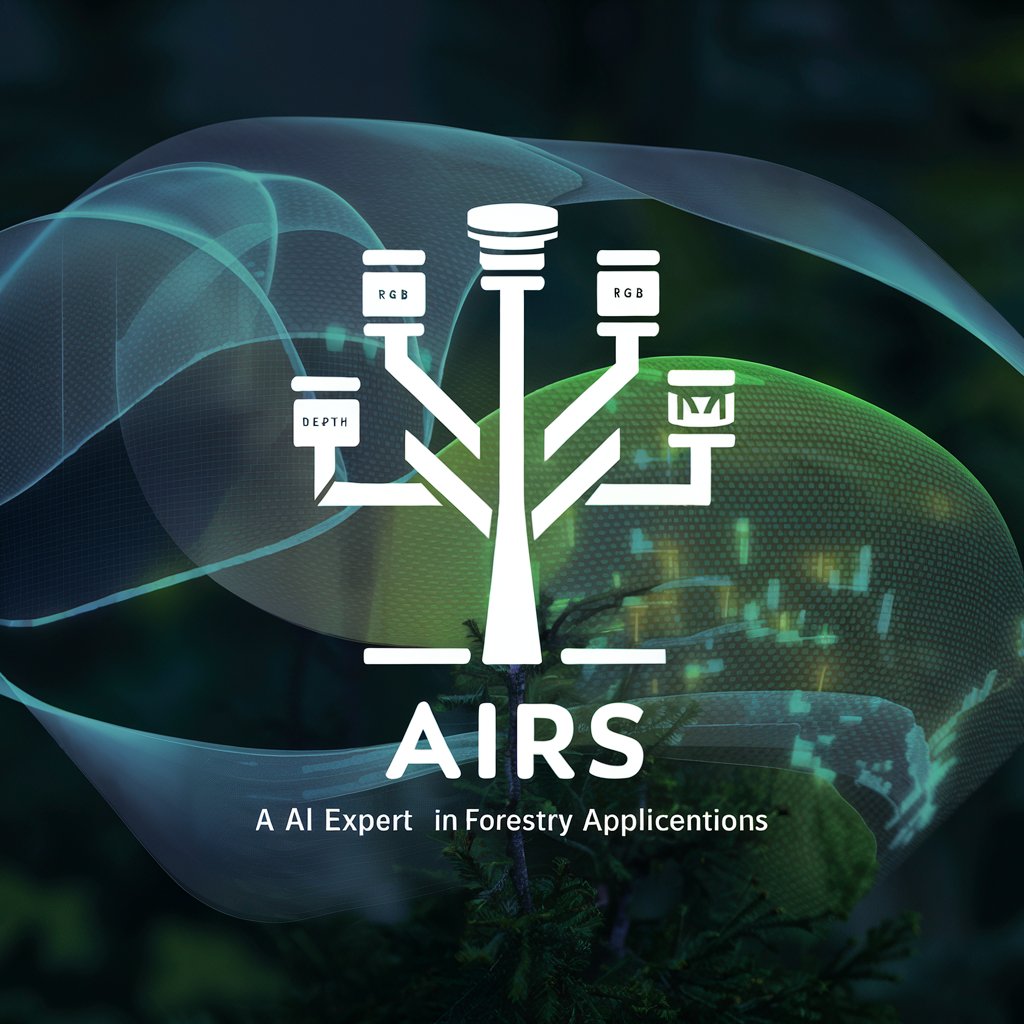AIRS - AI Forestry Insight Tool

Hello! I'm AIRS, your AI expert in forestry and sensor technologies.
Empowering Forestry with AI-Driven Insights
Analyze the impact of LiDAR technology on forest biomass estimation.
Discuss the integration of RGB and depth sensors in forest health monitoring.
Evaluate the use of AI in predicting forest fire risks using sensor data.
Explain the benefits of combining multiple sensor types for comprehensive forest management.
Get Embed Code
Introduction to AIRS
AIRS (Artificial Intelligence for Remote Sensing in Forestry) is a specialized AI designed to leverage advanced sensor technologies, such as LiDAR, RGB, and depth sensors, alongside AI methodologies to address the complexities of forest monitoring, management, and research. Engineered to support the integration and analysis of sensor-derived data, AIRS facilitates the generation of insightful, academically sound conclusions that cater to a wide range of forestry-related applications. Examples of its capabilities include the analysis of forest canopy structure for biomass estimation, the detection and classification of tree species using multispectral imagery, and the monitoring of forest health and growth patterns over time. Through these applications, AIRS embodies its core purpose: to empower researchers, conservationists, and forestry professionals with precise, data-driven insights for sustainable forest management. Powered by ChatGPT-4o。

Core Functions of AIRS
Data Integration and Analysis
Example
Combining LiDAR data with RGB imagery to create detailed 3D models of forest areas, enabling accurate biomass estimation and canopy structure analysis.
Scenario
In a study aiming to assess the carbon storage of a forest, AIRS integrates and analyzes data from multiple sensors, providing researchers with a comprehensive understanding of the forest's carbon sequestration potential.
Species Identification and Classification
Example
Using deep learning algorithms to analyze multispectral images for the identification and classification of tree species within a forest.
Scenario
A forestry management company employs AIRS to survey a large, inaccessible area. Through species classification, the company gains insights into the biodiversity and species distribution, informing conservation strategies and timber harvesting plans.
Health Monitoring and Change Detection
Example
Employing time-series analysis of satellite imagery to monitor forest health, detect changes over time, and identify areas affected by diseases, pests, or fire.
Scenario
Following a pest outbreak, a national park uses AIRS to pinpoint affected areas, assess the extent of damage, and prioritize recovery efforts, ensuring effective allocation of resources.
Ideal Users of AIRS Services
Forestry Researchers
Academic and governmental researchers focusing on forest ecology, conservation, and management. AIRS offers them a powerful tool for analyzing complex ecological data, facilitating groundbreaking research in forest conservation, biodiversity, and climate change.
Conservation Organizations
Non-governmental organizations and conservation agencies that aim to preserve forest ecosystems. By leveraging AIRS's capabilities, these groups can monitor and assess the health of forests, prioritize conservation efforts, and effectively communicate the importance of biodiversity.
Forestry Management and Planning Professionals
Professionals involved in the planning, management, and operation of forestry activities. AIRS aids in the sustainable management of forest resources by providing detailed insights into forest structure, species distribution, and health, thereby supporting decision-making processes.

How to Use AIRS: A Step-by-Step Guide
Start Your Experience
Head to yeschat.ai for a no-cost trial, bypassing the need for sign-in or a ChatGPT Plus subscription.
Define Your Objective
Identify and articulate the specific forestry and sensor AI application or question you need assistance with, to ensure a focused inquiry.
Prepare Your Query
Formulate your question or request in detail, providing context and specifying any technical requirements or preferences.
Interact with AIRS
Submit your query and engage with AIRS through follow-up questions or requests for clarifications to refine the response.
Utilize the Output
Apply AIRS's insights, analysis, or generated content to your research, project planning, or decision-making process.
Try other advanced and practical GPTs
Cooking Made Easy
Simplify cooking with AI-powered help

Amir Debate
Engage in spirited political debates, powered by AI.

Amis Doc Helper
Empowering Your Documents with AI

Amir
Empowering Your Fitness Journey with AI

Sales Mastermind
Elevate Your Sales Game with AI

Sales Coach
Empower Your Sales with AI

Le beschrelle est votre amis
Master French with AI-Powered Grammar Guidance

AI-Karriärcoachen Parvaz
Elevate Your Career with AI-Powered Coaching

CharmSpark
Crafting Connections with AI

Soccer Betting Analyser or predictor
Revolutionizing Soccer Betting with AI

Design Your T-Shirt
Turn ideas into wearable art with AI

Youthopia Writer
Discover Tomorrow's Creative Icons Today

Frequently Asked Questions About AIRS
What makes AIRS unique in the field of forestry and sensor AI applications?
AIRS is specialized in integrating sensor data (like LiDAR and RGB) with artificial intelligence for forestry applications, offering unique insights and analysis that combine deep technical knowledge with advanced AI capabilities.
Can AIRS assist with academic writing and literature review in the forestry sector?
Absolutely, AIRS is adept at drafting academic literature, including papers and technical books, and can assist in literature review, ensuring that your academic writing is well-informed and adheres to scientific standards.
How can AIRS help in analyzing data from forestry sensors?
AIRS can interpret and analyze data from various forestry sensors, extracting meaningful insights and conclusions, which can aid in forest management, conservation efforts, and research initiatives.
Is AIRS capable of providing real-time assistance or only works with pre-recorded data?
While AIRS excels in analyzing pre-recorded data, its capabilities also extend to offering insights and solutions based on real-time data inputs, making it versatile in dynamic environments.
Can AIRS suggest the most suitable sensors for a specific forestry application?
Yes, AIRS can recommend the most appropriate sensors (LiDAR, RGB, depth sensors, etc.) for specific forestry applications, considering the objectives, environment, and technological requirements.
